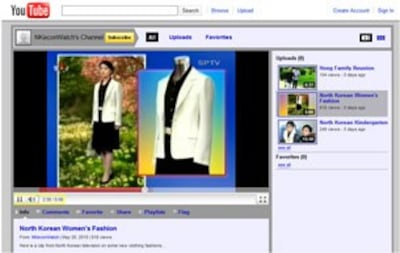SEOUL—The young models wore clothing adorned with bright pink lilies, golden bells, and lapels and pockets festooned with lace, all set against blossoming trees in picturesque spring settings.
White jacket and black skirt sets contrasted with traditional images of dark and drab formality that were the norm for North Korean women only a few years ago, according to North Korea's official televison.
The female anchor of the cultural program "Spring Fashion for Women's Formal Wear," produced by North Korea's official Korean Central News Agency (KCNA), declared au courant clothing that was "bright, [with] daring colors appropriate for the overall mood of spring."
Alongside a professor from the Pyongyang University of Fine Arts, the anchor said such vibrant colors “delight the eyes of those who see them, and invigorate the flavor and savor of the city streets.”
A video clip, posted on YouTube May 21 by George Mason University economist and North Korea watcher Curtis Melvin, sheds new light on the changing mores of the country’s women and how the Kim Jong Il regime is adjusting.
Melvin, who also compiles images of properties belonging to the leader of the ruling Workers' Party through satellite imagery and posts them on the Google Earth mapping system, called the clip “fascinating because it is a side of the DPRK [North Korea] that is rarely explored in the West.”
During the fashion review, the anchor carefully points to “the mood characteristic of women from our generation who try to look younger than their age and work with youthful enthusiasm,” a testament to a recent assertiveness North Korean career women display in society.
North Korean defectors recently arrived in South Korea say such confident fashion is increasingly common in the North Korean capital, Pyongyang.
They also say brighter colors first appeared in the northern capital as early as 2007, after North Koreans began to watch South Korean TV dramas for the first time.
But other defectors say such ostentation is likely limited to urban women who can afford it.
A North Korean defector who recently resettled in Washington said the difference between the “haves and have-nots [in North Korea] is astounding,” and that such bold styles are most likely popular only with Pyongyang residents, who are far more affluent than people living outside the capital.
Who wears the pants?

But despite the increasing acceptance of more modern fashion choices for North Korean women, noticeably absent from the new spring clothing review were pants.
While most North Korean working women labor to provide food for their families, the donning of clothing such as trousers, which allow farming and other manual work, is frowned upon.
The Communist regime instituted a penalty of hard labor or fines of up to one week’s salary for the average worker against any North Korean women caught wearing pants instead of skirts in a crackdown last year on public morals.
Agence France-Presse quoted human rights group Good Friends as saying that disciplinary officials from students’ bodies and women’s organizations supervise busy streets in the morning and at lunch time to take note of any women caught violating the ban.
In 1986, ruler Kim Jong Il issued a decree urging women to wear traditional Korean attire, calling traditional skirts and jackets a “source of our [national] pride.”
The ban on pants is not the first time the ruling regime has sought to control the appearance of its citizens.
Kim Jong Il also launched a campaign against untidy and foreign hairstyles, requiring men to keep their hair short and women to tie it up.
The same campaign denied women the right to wear skirts above the knee, tight trousers, flared trousers, or any garment that reveals the body's contours.
Women in North Korea are also banned from riding bicycles because it is considered “unbecoming.”
A new market economy
Andrei Lankov, a Seoul-based North Korea expert, said some of the measures come in response to a perceived threat from the country’s women, who are increasingly in charge of the illegal marketplaces formed following the failed government rationing systems of the 1990s.
"Women are overrepresented among the leaders of the growing post-Stalinist economy—at least at its grassroots level, among the market traders and small-time entrepreneurs," Lankov wrote in The Wall Street Journal.
Lankov said that despite the government failures of the 1990s, men in North Korea continued to go to work in order to avoid discrimination from the regime.
Women, who had more free time and were less scrutinized by the government in a traditionally patriarchal society, began to supplement their income by selling household goods and homemade foods, which eventually led to the formation of larger businesses.
Today, Lankov said, at least three-quarters of North Korean market vendors are women.
“For many North Korean women, the social disaster of the 1990s has become an opportunity to display their strength and intelligence,” he said.
“In recent months those women have become the primary target of government policies designed to destroy private enterprises. But the experience of the last two decades suggests that the women are likely to continue wearing the pants.”
Original reporting by Ahreum Jung for RFA’s Korean service. Korean service director: Bong Park. Translated from the Korean by Grigore Scarlatoiu. Written for the Web in English by Joshua Lipes. Edited by Sarah Jackson-Han.
